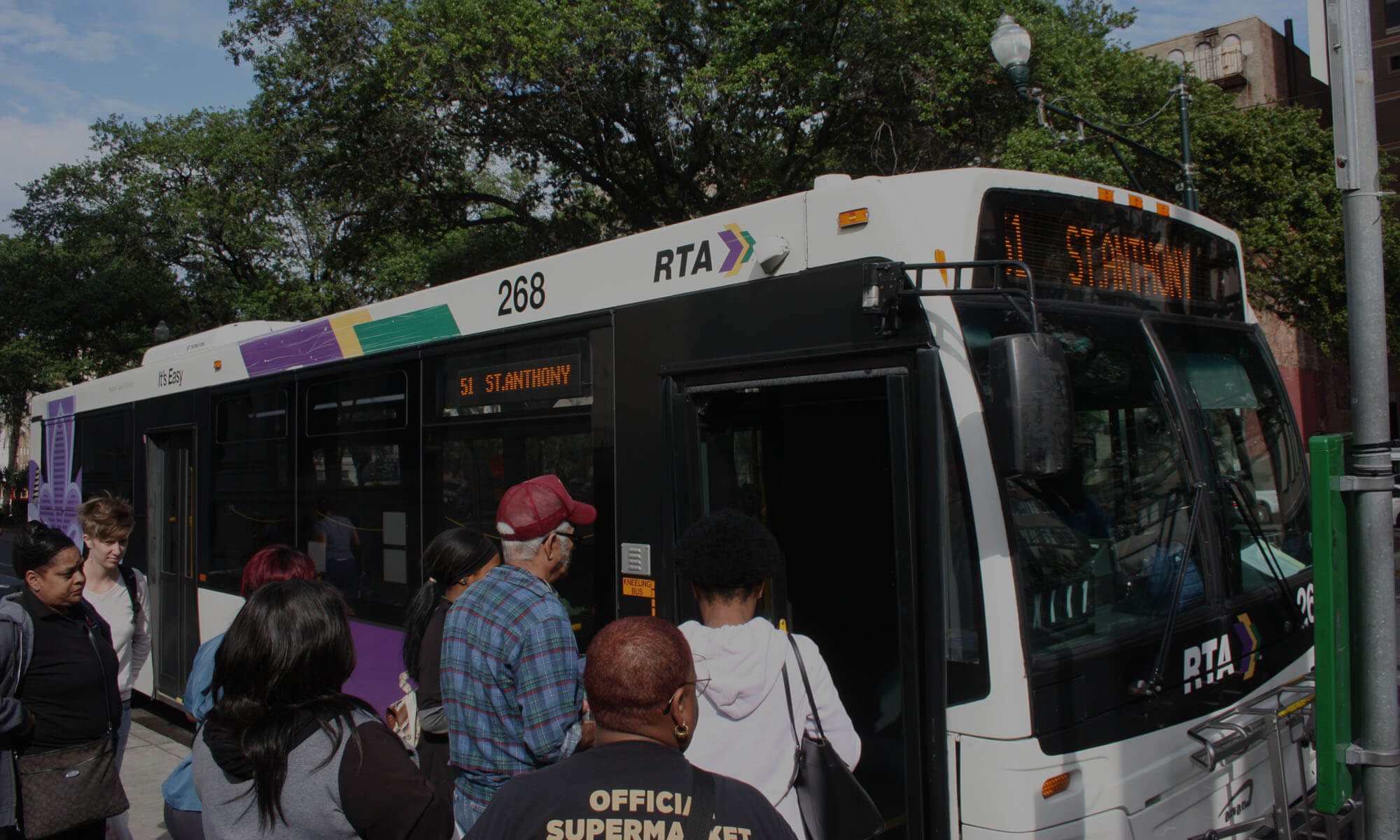With the New Links regional transit network redesign final proposal coming next week, we thought it would be a good time for a quick review on what New Links is, how we got to where we are right now, and what’s next. To take a detailed look at the draft proposal, you can go to NewLinksNola.com. The final proposal will also be posted there next week.
Refresher: What is New Links? Why do it?
Our regional transit system is not working – or least not working for many people. To name a few major problems, it takes way too long to get to most destinations, buses are unreliable and often late, and connecting across parish lines is difficult.
Black residents are especially impacted. Over half of Black residents in New Orleans live in neighborhoods with the worst access to jobs via transit, as categorized in RIDE’s 2020 State of Transit in New Orleans report.
But our immediate options for comprehensive improvements are limited. Ideally, the region should find more funding for transit and that’s a long-term goal of RIDE and many others. But discussions like that take time and riders are suffering now. Plus, even more funding wouldn’t help some of the problems with the current system.
So, the region considered a network redesign. A network redesign means redeploying transit resources (transit vehicles and operators, basically) to make the system work better. Practically, that means some lines are added, some lines are changed, some lines have more buses on them, some lines have less, and some lines are eliminated.
A number of other US cities have redesigned their bus networks recently, with big benefits for riders. Houston is a great example.
New Links itself is our region’s network redesign process. It started in early 2019 and consisted of LOTS of data gathering and analysis and LOTS of rider and community conversations. In general, a large majority of the community – transit riders especially – said they would be willing to see changes IF it meant service would be more frequent (more buses each hour), more reliable (buses and streetcars that are on time) and more regional (transit that connected reliably to more places across parish lines).
Ok, what does that actually mean for me?
The New Links draft proposal proposed a lot of changes to the network – too many to go into individually in this post. You can see the specific changes at NewLinksNola.com. But you can sum up the changes as three big improvements and two associated tradeoffs.
Benefits
- A high frequency network! Right now there’s only three lines that come every 15 minutes or less and on 2/3 of the region’s transit lines it’s more than every 30 minutes – AT BEST. This is the central reason why the transit system is so frustrating for so many riders and so bad at getting most people to work on time. New Links would completely change this by creating a new high frequency spine for the system with every neighborhood being near a bus or streetcar line that arrives every 20 minutes or less, 7 days a week, from early in the morning to late at night. The proposal would double the number of lines like this, going from 8 to 16. This is the most important thing to turn our unreliable current system into a flexible transportation system many more people can rely on.
- Buses that come when they say they’re going to come! New Links proposes to shorten and simplify lines, which means it will be MUCH easier to keep them on time. That’s a huge win for riders – the number one complaint we see most years is that buses are often late or never show up. More frequent buses also means that even when a bus breaks down – another one comes before you wait too long.
- More regional destinations! The New Links proposal means two new high frequency regional routes that go from Elmwood to the New Orleans CBD and the airport to the New Orleans CBD via the Veterans Corridor. That should cut travel time significantly for travel between the region’s three largest concentrations of jobs. The proposal also envisions better connections between the parish on the West Bank, with both systems transferring at the Wilty Terminal in Gretna, meaning riders don’t have to ride all the way into the CBD just to go between parishes on the West Bank.
Tradeoffs
Beyond the temporary disruption of a big change, there are two tradeoffs:
- More transfers for some. That can sound scary at first, but transferring would be a very different experience in the new system. Right now, when you transfer, you’re transferring from one bus line that doesn’t come very often to another bus line that doesn’t come very often. That means really long, unpredictable waits – something no one wants to deal with. But with the New Links proposal, buses would be much more frequent – especially on major routes. That means on average, riders will wait 10 minutes or less and, in many cases, much less. Transferring would become a more predictable and manageable experience.
- A small number of riders will have to walk a little further. Again, that can sound scary at first. But the vast majority of riders (96 percent) will still catch a bus at their existing stops (though there might be a more frequent bus line within walking distance nearby). 99 percent of riders will still have a bus stop within a 5 minute walk of where they currently catch the bus. In return for this tradeoff, riders will see the frequency, reliability, and destination improvements noted above.
Great, so I should support this?
From our perspective, absolutely, yes!
The system doesn’t work the way it needs to right now. It’s not reliable, it’s not frequent, it doesn’t get you to many destinations that you need to get to in a reasonable amount of time. And the deficiencies harm communities of color and lower-income families the worst.
New Links will mean a system that is predictable and frequent, where it is reasonable to expect to be able to get to most major destinations, seven days a week, in under an hour of travel time, and, in many cases much less. There will still be a lot of work to do – but this will be a strong basis for moving forward into the future.
Helping Black and lower-income riders
Importantly, the people who need to see improvements the most will gain the most. The New Links team specifically prioritized lower-income neighborhoods, riders of color, and households without access to a private vehicle in making decisions about where to put higher levels of service.
In the draft New Links proposal, the number of residents of color within walking distance of frequent transit (every 20 minutes or less) would more than double!
We think the New Links plan would be groundbreaking for the region in really putting disadvantaged and long-ignored communities first. That alone is a good reason to consider supporting New Links!
What happens next
Next up is for the RTA and Jefferson Transit to formally consider the New Links proposal. Both agencies have been full partners on the proposal, but the Regional Planning Commission (RPC) has formally led the process. When the final report is finished next week, the RPC will turn it over to the transit agencies who will then determine the next steps.
We don’t know yet what the Jefferson Parish process might look like, but the RTA process will likely go like this:
- New Links introduced at the February 11 RTA Operations Committee (9 a.m.)
- New Links discussed at the February 23 RTA full board meeting (10 a.m.)
- RTA board votes on New Links at the March 23 full board meeting (10 a.m.)
Even assuming the RTA board votes to fully approve New Links, there would still likely be a nine-to-twelve-month implementation process. Changing the entire network takes a lot of prep work! The soonest we’d likely see any big changes is early 2022.
Now – whether the RTA board will approve New Links or not is still an open question. We believe they recognize the problems with the system and understand how New Links could fix them. Individual RTA board members have generally said very supportive things in public and in conversations with RIDE. But there has been no formal commitment and concerns about reduced funding during the COVID pandemic or worries about big changes could still slow this down.
We hope that’s not the case. If you agree, let the RTA know you want to see New Links move forward by sending a note via their online comment form!
We’ll keep you posted as we move forward in the next few weeks. If you have thoughts or questions, please email us at info@rideneworleans.org.

